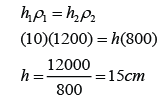- Pressure in liquid is owing to the weight of the liquid acting on the surface of any objects in the liquid.
- Pressure of a liquid is directly proportional to
- the gravitational field strength
- the depth
- density of the liquid.
- Pressure in liquids is not affected by the size or shape of the object.
- The pressure caused by a liquid and the pressure in a liquid can be determined by using the equation below:
Pressure Caused by Liquid

Pressure in Liquid

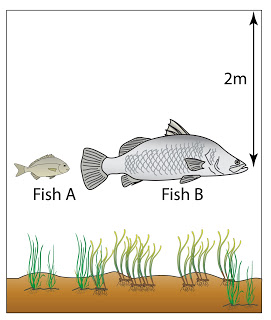
The diagram shows 2 fishes in water. The density of the water is 1025 kg/m³. The surface area of fish A is 300 cm² and the surface area of fish B is 2000cm². Find
a. the pressure exerted by the water on fish A.
b. the pressure exerted by the water on fish B.
c. the force exerted by the water on fish A.
d. the force exerted by the water on fish B.
Answer:
This question would like us to compare the liquid pressure exerted on 2 objects of different size in the same depth of water.
a.
Depth, h = 2m
Density, ρ = 1025 kg/m³
Gravitational Field Strength, g = 10 N/kg
Pressure exerted by water on fish A,

b. Pressure exerted by water on fish B,

(Note: Pressure exerted both fishes are the same. Pressure caused by liquid is not affected by the size or shape of the objects)
c.
Surface area of fish A, A1 = 300 cm² = 0.03 m²
Force exerted by the liquid pressure,

d. Surface area of fish B, A2 = 2000cm² = 0.2 m²
Force exerted by the liquid pressure,
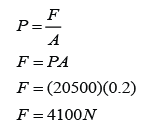
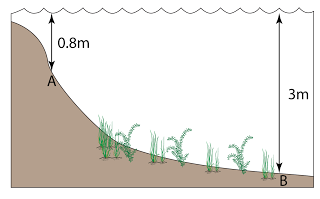
Figure above shows the cross section of a sea near a seaside. Find the difference of the pressure between point A and point B. [Density of seawater = 1050kg/m³]
Answer:
Density, ρ = 1050kg/m³
Gravitational Field Strength, g = 10 N/kg
At point A:
Depth, h = 0.8 m

At point B:
Depth, h = 3 m

Pressure Difference

Example 3:
Find the pressure at a depth of 20 m in water when the atmospheric pressure is 100000 Pa. The density of water is 1000 kg/m³.
Answer:
(Caution: Pressure in liquid = Pressure caused by liquid + Atmospheric Pressure)
Depth, h = 20m
Density, = 1000 kg/m³
Gravitational Field Strength, g = 10 N/kg
Atmospheric Pressure, Patm = 100000 Pa
Pressure in water,

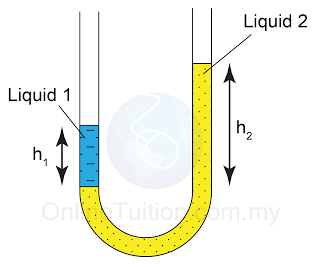
- Usually, a U-tube is used to compare and measure density of liquids.
- The density of the 2 liquids is related by the equation:

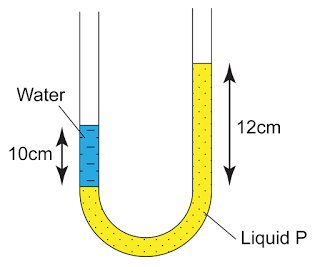
Figure above shows a U-tube filled with water and liquid P. Liquid P is insoluble in water. Given that the density of water is 1000kg/m³, find the density of liquid P.
Answer:
h1 = 10cm
h2 = 12 cm
ρ1 = 1000kg/m³
ρ2 = ?

The density of liquid P = 833 kg/m³

The diagram shows a U-tube filled with two types of liquid, X and Y which are not mixable. If the density of liquid X and liquid Y are 1200 kg/m³ and 800 kg/m³ respectively, find the value of h.
Answer:
h1 = 10cm
h2 = h
ρ1 = 800kg/m³
ρ2 = 1200kg/m³
